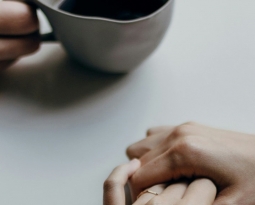Despite what M&S, John Lewis or Aldi would have us believe about Christmas, for many people, Christmas is a time of stress – a time when we may feel under pressure and depleted emotionally, physically, relationally and financially. Often other people’s Christmas wishes are prioritised over our own. Expectations of ourselves and others may bring up feelings of guilt, perfectionism and disappointment. Isolation, obligation and suffocation may also sit painfully. Unfortunately, the continuing Coronavirus pandemic adds to the stress – it’s an uncertain time and can increase a sense of loss of control.
Understanding how to soothe and calm ourselves at such a challenging time is really important for both our emotional and physical wellbeing – it can help us get through tough moments and to cope more effectively when we are feeling overwhelmed.
As a starting point, it can be helpful to acknowledge that soothing ourselves, is not about stopping how we feel in that moment, but rather about helping “ride the wave” of this and reduce the intensity of the feelings. We can’t stop stressful experiences happening, but we can start to manage how we respond to them differently.
One way of starting to regulate our feelings is to turn our attention to what is happening in our body during difficult moments. At these times of overwhelm, checking in with body and being curious, not judgemental, about what it might need is useful and a step towards regulating ourselves. Calming the body can be a start to calming the mind.
“If you want to change the story, start by changing the state” – Deb Dana
Our body is first to give a signal that we don’t feel great. When you tune in, you might notice that your body is responding to stress in a particular way. For example, nervous tummy, sweating, trembling, heart racing, feeling sick, pacing, sitting very still or even a panic attack.
Sometimes it is difficult to make sense of these reactions & not understanding why they are happening can be even more unsettling or overwhelming. Nonetheless, your nervous system is simply doing what it is designed to do and sending a signal to the brain that something doesn’t feel right – this might seem in line with your stress at that moment; or out of kilter with it.
Creating a “pause” can allow a moment of space, no matter how brief; it causes a sort of “circuit break” and be created in different ways. It can then allow you some space with which to carry on calming your body and/or to start help making a bit more sense of what is going on.
You may be able to do this in the place you find your body responding or perhaps you need to leave to find a quiet, safer feeling place – this is all part of the “pause”. You might want to sit, stand, lie down, have your eyes open or closed – what feels best for you?
SIGHING – This is a great way to create a pause and it is something we all do very naturally, sometimes unaware that we are doing it to relieve stress; it is an involuntary need for a pause.
- Take a big breath in through your nose, hold this for 2 seconds, then let a forceful sigh out. Do this twice.
- Continue to breath in and out with a sigh, but with a gradually less forceful and longer sigh out until your breathing feels more regulated and you feel a little calmer.
BREATHING – Creating a pause can allow space to check in with your body & maybe do more breathing to help regulate your breath. Breathing in and out to a rhythm that suits you – starting slowly, keeping to the same slow in & out rhythm/count until your breath becomes calmer and back to its natural rhythm.
NOTICING without judging. Telling yourself off for your responses only re-enforces the body’s reactions and makes them worse. Notice and listen to what it needs, then give yourself permission to do this.
ANCHORING
Anchors are experiences that are either real or imagined that help to pause, soothe and regulate intense feelings in your body. You can have different anchors for different feelings. For example, anchors for when you feel angry; different ones for when you feel lonely or scared.
Anchors are a ‘who’, ‘what’, ‘where’ and ‘when’ that feels nourishing; brings moments of being alive; helps to calm & soothe; helps you to feel connected with yourself or another. Start to notice how your body feels when you connect with your anchors. Some examples below:
Who – who in your life brings a feeling of safety and calm? It could be a person or a pet.
What – Walking the dog; looking out your window; the sound of rain on the roof; holding your lucky stone; watching a favourite film; lighting candles; knitting; playing cards. Music is another great example – what helps you to tune into your inner rock star or calm the internal chaos?
Where – The woods; by the sea; your garden; driving your car; your grandma’s house;
When – Climbing into bed at the end of the day; being the first up in the morning; when the kids are asleep;
These anchors may be something you can actively pause and connect with or do; or pause to take time to imagine or look at pictures. You could start to gather a list of anchors – illustrate them; use photos or sticky notes to remind you of them. Put them in a place where you can see them easily – what works best for you?
You may not be able to find anchors for each heading – that is ok. Focus on those you can find. Add to the list when you find another one – keep a look out for them; it can take practice to become aware of them. How do they help you feel more ok? How does your body feel with them?
Of course, during the pandemic, connecting with some of your anchors might be challenging. For example, meeting with someone or going somewhere is not always possible or maybe feels too overwhelming, but texting or a phone call feels ok. How can you adapt your anchors to still be helpful to you?
Pausing is just a starting point – looking out for and tuning into ourselves can feel strange if we are not used to doing this. We often notice the moments that make us feel less ok but taking time out to notice when we feel a little bit better or lighter can also help us realise ways regulate our moments of overwhelm. It just takes small steps… and pauses…one at a time.
Written by Claire, Westmeria tutor and counsellor









